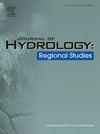Synchronicity analysis of meteorological variables on agricultural drought in the Loess Plateau, China
IF 4.7
2区 地球科学
Q1 WATER RESOURCES
引用次数: 0
Abstract
Study region
This study focuses on the Wuding River Basin, located in the middle reaches of the Yellow River Basin in China.
Study focus
Event Synchronization (ES) and Event Coincidence Analysis (ECA) were used to investigate the spatiotemporal co-evolution of the multi type of meteorological variable drought (SIMVs) and SSMI in the basin, including the precursor and triggering effect of SIMVs on agricultural drought and the occurrence and development of different levels of agricultural drought events under meteorological variable disturbance.
New hydrological insights for the region
In the precursor-and-trigger analysis of ECA, SWI was the main precursor and trigger factor for mild agricultural drought and SPI for moderate and severe drought. The precursor coincidence rate is higher than the trigger coincidence rate, suggesting that not all precursory SIMV events cause agricultural drought. All precursory and triggering effects diminish as the observation time window rises, demonstrating that SIMV has a bigger impact on low-grade agricultural drought. SPI caused 26.86 % of agricultural drought, whereas coupled SIMVs triggered it. The synchronization analysis shows that the lag times for SPI, STI, SWI, and SNR early warnings of drought are 65.7 days, 60.5 days, 52.8 days, and 55.8 days, respectively. The lag times for SIMV triggers are 61.8 days, 53.7 days, 48.4 days, and 53 days.
求助全文
约1分钟内获得全文
求助全文
来源期刊

Journal of Hydrology-Regional Studies
Earth and Planetary Sciences-Earth and Planetary Sciences (miscellaneous)
CiteScore
6.70
自引率
8.50%
发文量
284
审稿时长
60 days
期刊介绍:
Journal of Hydrology: Regional Studies publishes original research papers enhancing the science of hydrology and aiming at region-specific problems, past and future conditions, analysis, review and solutions. The journal particularly welcomes research papers that deliver new insights into region-specific hydrological processes and responses to changing conditions, as well as contributions that incorporate interdisciplinarity and translational science.
 求助内容:
求助内容: 应助结果提醒方式:
应助结果提醒方式:


